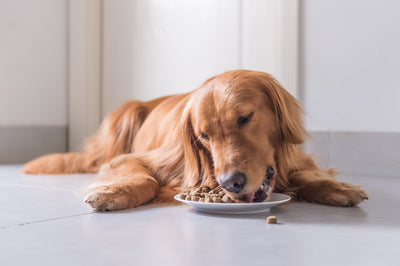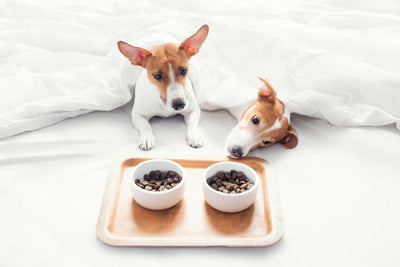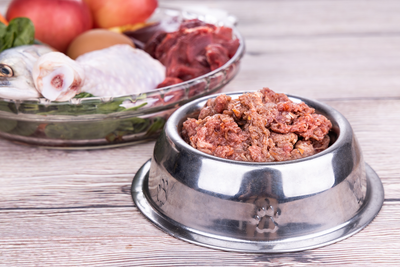“For the best nutrition you need raw or freeze dried. To the extent that budget permits, include raw food in your pet’s diet. Your pet’s vitality will be louder and longer, medical bills lower (gum health much improved), and both you and your pet will be happier.”
Richard S Patton PhD – Animal Nutritionist
What is a Raw Diet?
A raw pet food diet is designed to mimic what our pets would naturally be eating in the wild. Like their undomesticated ancestors, our dogs and cats have a built-in instinctive carnivorous bias to consume other whole animals - organs, bones, and all. With that said, raw diets are typically comprised of raw meat, bone, organ matter, fruits, vegetables, and different vitamins and minerals to make it complete and balanced. Raw diets are also not subject to any form of heat processing to preserve the nutritional integrity of the ingredients.
Benefits of a Raw Diet
Raw diets have many known benefits amongst the pet parent community, including but not limited to healthier skin and coat, reduced allergies, improved dental health, and improved gastrointestinal health.
Healthier Skin and Coat:
About 40% of the protein your pet ingests goes towards the production and maintenance of their skin and coat. A dry or processed diet typically does not provide the same level of absorbable protein as a raw diet would to maintain nourished skin and a healthy coat. Raw diets are also rich in omega fatty acids which assist in the maintenance of their skin and coat.
Reduced Allergies:
Many pets show some sort of adverse reaction to different kibble fillers, such as grains and excess starches. Raw diets cut out those unnecessary fillers, and in most cases will add in antioxidant rich fruits and vegetables that will assist in regulating your pet’s immune system. Raw diets will typically also contain a balanced combination of omega 3, 6, & 9’s which acts as a natural anti-inflammatory to reduce skin irritations.
Improved Dental Health:
According to the Veterinary Institute of Integrative Medicine, feeding raw diets can improve overall dental health. Fibers in tough meat “act much like dental floss in helping to clean between your dog’s teeth,” they explain. Raw diets and treats (such as raw bones) also raise the acidity level in the pet’s mouth which kills bad bacteria and promotes healthy oral hygiene. Raw diets also contain significantly less starchy carbohydrates than a basic processed diet, which is what causes plaque buildup.
Improved Gastrointestinal Health:
Unprocessed foods, such as a raw diet, provide the maximum amount of absorbable nutrients with zero “nonessential” ingredients, making it extremely digestible. The digestive enzymes present in raw diets help promote a healthy environment for good bacteria and a not so optimal environment for the bad. The overall results are a happier, healthier gut.
Research That Supports Raw Diets
Raw Meat-Based Diets in Dogs and Cats:
https://www.ncbi.nlm.nih.gov/pmc/articles/PMC5644655/pdf/vetsci-04-00033.pdf
Low Number of Owner-Reported Suspected Transmission of Foodborne Pathogens From Raw Meat-Based Diets Fed to Dogs and/or Cats:
https://www.frontiersin.org/articles/10.3389/fvets.2021.741575/full
The relationships between environment, diet, transcriptome and atopic dermatitis in dogs:
https://helda.helsinki.fi/handle/10138/231737
Raw Diet Risks
Just like any commercial pet food, there are different contamination risks to consider, the most common ones being salmonella and listeria. Both bacteria can cause gastrointestinal upset, such as vomiting and diarrhea. Salmonella is typically no real danger to healthy adult dogs or cats due to their short digestive tract but can pose concern for young or immune-compromised pets. The concern is more for the owners coming in contact with the pathogen and then contracting it. Remembering to use safe-handling practices when serving a raw diet can mitigate these risks.
Transitioning to Raw
The easiest way to begin is by replacing roughly 25% of your pet’s diet with raw for a couple of days. Once that period passes, and no issues arise, increase by another 25%, so their diet will be 50% raw and 50% their old food. Continue this way until you can completely switch over to 100% raw. If you do notice any kind of tummy upset during this transition period, try adding pumpkin puree or goat milk; the added probiotics and soluble fiber will help soothe your pet’s digestive system.

When first introducing your pet to a raw diet many customers report seeing immediate changes in the pet’s over-all appearance and energy levels; others state it takes a couple of weeks before notable changes are seen. In either case, a gradual transition is the best way to introduce raw into your pet’s diet. Whether your plan is to fully transition your pet to 100% raw or just introduce it as a special topper, any amount of raw will reap benefits for your pet.
Citations:
https://www.sportmix.com/faq/transition-chart/
https://pattonanimalnutrition.com/what-to-feed-your-dog/
https://primalpetfoods.com/search?q=raw+feeding






